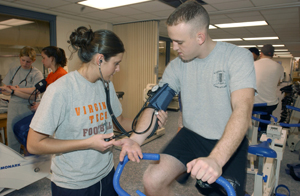 |
|
|
Although scientists recognize that there is a genetic component to obesity, that's not the primary culprit. "Genes haven't changed--lifestyles have," says Rankin. "When you look at body weight, you have to look at calories in and calories out. Today, we are eating more calories. It's no wonder--we’re constantly inundated with food. Advertising for food is constant and restaurant portions are twice what they should be. It's almost surprising that we don't have more overweight people," she adds. As well, people today tend to be more sedentary, both at work and at home. "In general, our environment is not conducive to being active, and people don't exercise much," Rankin says. For example, at work, people are more likely to be at a computer all day, and at home, they're watching television or surfing the Internet. Rankin and others in her department are searching for ways to fight the obesity problem. "We know that cardiovascular disease kills more adults in the U.S. than any other problem and that obese people have a higher chance of developing this," she explains. "We're finding that one mechanism causing the disease might be a condition called elevated chronic inflammation." Inflammation is a natural process that is usually triggered when the body is fighting an infection or there is an injury or a pathogen. The researchers are finding, however, that some chemicals in the cells stimulated by inflammation can cause problems if they are elevated all the time. "Anybody who has this elevated inflammation is at risk for chronic heart disease--something about the inflammation is causing this," Rankin notes. "We've found that the more people's body fat increases, the more chronic inflammation there is. So what our research is asking is, 'Can we can change this inflammation through lifestyle changes?'" Calories in, calories out
To examine the effects of one such diet, Rankin and other researchers recently compared the inflammation markers--which help to measure levels of inflammation--of people on the Atkins Diet to those on Weight Watchers or a similar low-fat diet. Both groups of dieters lost weight, with the Atkins group losing slightly more, but the inflammation markers for the low-fat and balanced diet group decreased while those for the low-carb group increased. To Rankin, these results prove that not only are the long-term effects of such diets unknown, but also that the diets are potentially harmful. Instead, she says, people should just use common sense when it comes to losing weight, including • Being aware that it shouldn't be easy to lose weight. "If it took a year to put it on, you can't take it off in four weeks for your class reunion," Rankin says. "Your body can't handle that."
• Including protein with each meal, which will help your body feel full for a longer time. • Making sure you rack up at least 30 cumulative minutes of exercise every day. • Repeating the mantra, "In the long run, this is going to be worth it." The last tip is especially important. "Americans know that weight is an important issue," notes Rankin. "During a national telephone survey about health issues, more than 40 percent of women and 30 percent of men said that they were trying to lose weight."If, then, Americans are aware that they may have weight problems, why haven't the statistics changed? "Actually losing weight is hard," Rankin says. "It means eating less than you want and doing activity when you don't want to. It's like trying to stop smoking or to change your sleep habits." Yet because the benefits of a good diet and exercise far outweigh the inconveniences, she stresses the importance of making such lifestyle changes. If you need further convincing, simply reread the introduction to this article. |
||||||||||||||||||||||||||||||
|
Home | Alumni Association | Alumni Shorts | Archives | Book Notes | Class Notes | Corps of Cadets
Editors | Features | Hok-E-News | In Retrospect | Letters | News | Philanthropy | President's Message |


